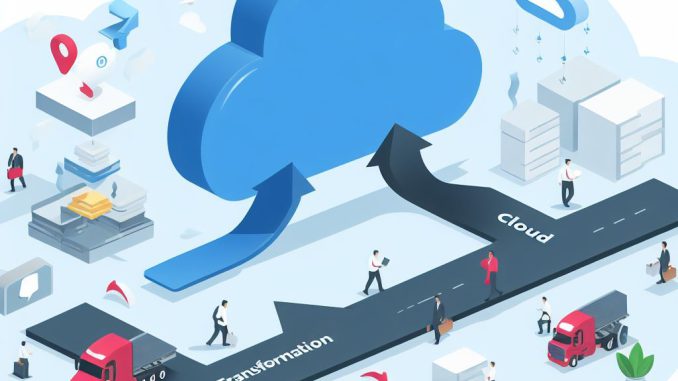
If you are considering moving your business to the cloud, you may have heard of two different approaches: cloud migration and cloud transformation. But what are they, and how do they differ? And more importantly, which one should you choose for your specific needs?
I understand it is not something new, the whole “cloud thing”, “digital transformation”, but let’s “clear the air” a little bit 🙂
Cloud Migration vs. Cloud Transformation: Definitions
Cloud migration is the process of moving your existing applications, data, or other IT resources from your on-premises infrastructure to a cloud platform. This can be a public cloud, such as AWS, Azure, or Google Cloud, a private cloud, or a hybrid cloud that combines both. The main goal of cloud migration is to replicate your on-premises workloads in the cloud, without making major changes to their architecture or functionality.
Cloud transformation, on the other hand, is the process of redesigning and transforming your applications, data, or other IT resources to optimize them for the cloud. This means taking advantage of the unique features and services that cloud platforms offer, such as scalability, elasticity, performance, security, and automation. The main goal of cloud transformation is to create a cloud-native IT environment that leverages the full potential of cloud computing.
Cloud Migration vs. Cloud Transformation: Similarities
Both cloud migration and cloud transformation share some common benefits and challenges. For example, both strategies can help you:
- Reduce costs by eliminating the need for maintaining and upgrading your own infrastructure.
- Increase scalability by accessing virtually unlimited resources on demand.
- Improve reliability by ensuring high availability and fault tolerance.
- Enhance security by using encryption, identity management, and compliance tools.
- Innovate faster by accelerating development and deployment cycles.
However, both strategies also come with some risks and difficulties, such as:
- Choosing the right cloud platform and service model for your needs.
- Planning and executing a smooth transition without disrupting your business operations.
- Managing data privacy and sovereignty issues across different regions and jurisdictions.
- Training and upskilling your staff to use new tools and processes.
- Monitoring and optimizing your cloud performance and costs.
Cloud Migration vs. Cloud Transformation: Differences
While cloud migration and cloud transformation have some similarities, they also have some key differences that affect their outcomes and requirements. Here are some of the main differences between them:
- Complexity: Cloud migration is usually less complex than cloud transformation, as it involves fewer changes to your existing workloads. Cloud transformation requires more planning, design, development, testing, and deployment efforts to rebuild your workloads for the cloud.
- Risk: Cloud migration is usually less risky than cloud transformation, as it involves less disruption to your business operations. Cloud transformation involves more uncertainty and potential issues due to the significant changes to your workloads.
- Time: Cloud migration is usually faster than cloud transformation, as it involves less work to move your workloads to the cloud. Cloud transformation takes longer due to the additional steps involved in transforming your workloads.
- Cost: Cloud migration is usually cheaper than cloud transformation in the short term, as it involves less investment in new tools and resources. Cloud transformation may require more upfront costs due to the need for new development and testing environments.
- Benefit: Cloud migration can provide immediate benefits in terms of cost savings, scalability, reliability, and security. However, these benefits may be limited by the constraints of your existing workloads. Cloud transformation can provide greater benefits in terms of performance, flexibility, innovation, and differentiation. However, these benefits may take longer to realize due to the time required for transformation.
Cloud Migration vs. Cloud Transformation: What to Use When
So how do you decide whether to use cloud migration or cloud transformation for your business? There is no definitive answer to this question, as it depends on various factors such as your goals, resources, timeline, budget, and IT landscape. However, here are some general guidelines that can help you make an informed decision:
- Use cloud migration when you want to move existing systems and applications to the cloud with minimal disruption and change. This is a good option if you have limited time, budget, or expertise; if your existing workloads are stable and well-functioning; or if you want to test the waters before committing to a full-scale transformation.
- Use cloud transformation when you want to create a cloud-native IT environment that takes full advantage of the benefits of cloud computing. This is a good option if you have more time, budget, or expertise; if your existing workloads are outdated or inefficient; or if you want to gain a competitive edge by innovating faster and better.
Conclusion
Cloud migration and cloud transformation are two different approaches to moving your business to the cloud. Both have their pros and cons, and both require careful planning and execution. The best strategy for you depends on your specific needs and circumstances. By understanding the similarities and differences between cloud migration and cloud transformation, you can choose the right approach for your cloud journey and achieve the best results for your business.
Additional information/links
Cloud adoption in the era of accelerated Digital Transformation (3-part series)
Azure FinOps: What it is and Why it matters
Migrating Infrastructure to MS Azure using Cloud Adoption Framework (CAF) | GitHub

Be the first to comment